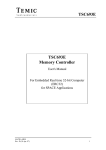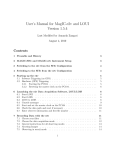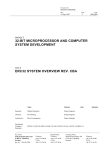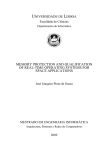Download The ERC32 GNU Cross-Compiler System
Transcript
The ERC32 GNU Cross-Compiler System Version 1.3 January 1998 Jiri Gaisler European Space Research and Technology Centre (ESA/ESTEC) 2 ERC32 GNU Cross-Compiler system European Space Agency [email protected] The ERC32 GNU cross-compiler system Copyright 1998 European Space Agency. Permission is granted to make and distribute verbatim copies of this manual provided the copyright notice and this permission notice are preserved on all copies. Permission is granted to copy and distribute modified versions of this manual under the conditions for verbatim copying, provided also that the entire resulting derived work is distributed under the terms of a permission notice identical to this one. Permission is granted to copy and distribute translations of this manual into another language, under the above conditions for modified versions. Introduction 3 1 Introduction 1.1 General This document describes the ERC32 GNU cross-compiler system version 1.3. Discussions are provided for the following topics: • contents and directory structure of ERC32CCS • compiling and linking ERC32 applications • usage of SIS and MKPROM • debugging ERC32 application with GDB/SIS The ERC32 GNU cross-compiler system is a multi-platform development system based on the GNU family of freely available tools with additional ‘point’ tools developed by Cygnus, OAR and ESTEC. The ERC32CCS consists of the following packages: • EGCS/GCC C/C++ compiler • GNAT Ada95 compiler • GNU binary utilities • RTEMS C/C++ real-time kernel • Newlib standalone C-library • SIS ERC32 simulator • GDB debugger with ERC32 remote debugging monitor (rdbmon) • DDD graphical front-end for GDB • MKPROM boot-prom builder 1.2 News in version 1.3 This version of ERC32CCS contains the following changes with respect to 1.2: • DDD version 2.2, including new documentation • Modified assembler to compensate newly discovered FPU rev.B bugs • Egcs-1.0 C/C++ compiler • RTEMS 4.0 beta release with simplified compile procedure • Experimental Ada95 compiler based on gnat-3.10 and rtems-4.0 • Re-compiled floating-point library (libm.a) to incorporate the FPU fixes • GDB version 4.16.1 with gnat support • SIS version 2.7.6 4 ERC32 GNU Cross-Compiler system 2 Installation and directory structure 2.1 Obtaining ERC32CCS ERC32CCS is only distributed via anonymous ftp. The primary home of ERC32CCS is the ESTEC ftp-server at ftp:/ /ftp.estec.esa.nl/pub/ws/wsd/erc32/erc32ccs. Two platforms are supported: SUN Sparcstaion (SunOS & Solaris) and PC/Linux. Sources for rdbmon and mkprom are provided with ERC32CCS, the remaining sources can be found at the usual GNU sites. 2.2 Installation The ERC32CCS directory tree is compiled to reside in /usr/local/erc32. After obtaining the compressed tarfile with the binary distribution, un-compress and un-tar it in a suitable location - if this is not /usr/local/erc32 then a link have to be created to point to the location of the ERC32CCS directory. The distribution can be installed with the following command: gunzip -c erc32ccs-1.3.tar.gz | tar xf This will create the erc32 directory in the current directory. The erc32 contains the following sub-directories: bin doc include lib man rtems rtemsnp sparc-rtems src executables documentation host includes host libraries man pages rtems libraries rtems libraries (no posix) target libraries (ERC32) various sources Documentation for the various packages can be found in doc, while unix-style man-pages are in man. Note that the directory structure for ERC32CCS-1.3 has changed and is not compatible with ERC32CCS-1.2. 2.3 Environment ERC32CCS does not longer require any environment variables to be set; just add /usr/local/erc32/bin to your search path. 2.4 Support For technical support regarding GNU tools, contact Cygnus at http://www.cygnus.com/. For RTEMS support contact OAR at http://www.oarcorp.com/. For SIS and MkProm support, contact J.Gaisler (ESTEC) at [email protected]. Using ERC32CCS 5 3 Using ERC32CCS 3.1 ERC32CCS tools The following tools are included in ERC32CCS: ddd fcheck mkprom protoize sis sis64 sparc-rtems-ar sparc-rtems-as sparc-rtems-c++ sparc-rtems-c++filt sparc-rtems-g++ sparc-rtems-gasp sparc-rtems-gcc sparc-rtems-gdb sparc-rtems-gdb64 sparc-rtems-gnatcmd sparc-rtems-gnatmake sparc-rtems-gnatbind sparc-rtems-gnatf sparc-rtems-gnatprep sparc-rtems-gnatbl sparc-rtems-gnatkr sparc-rtems-gnatpsta sparc-rtems-gnatchop sparc-rtems-gnatlink sparc-rtems-gnatpsys sparc-rtems-gnatchp sparc-rtems-gnatls sparc-rtems-ld sparc-rtems-nm sparc-rtems-objcopy sparc-rtems-objdump sparc-rtems-ranlib sparc-rtems-size sparc-rtems-strings sparc-rtems-strip unprotoize graphic X11 front-end to GDB utility to check for FPU rev.B bugs boot-prom builder GNU protoize utility ERC32 simulator ERC32 simulator (with 64-bit time) library archiver modified cross-assembler (FPU rev.B fixes) C++ cross-compiler utility to demangle C++ symbols same as sparc-rtems-c++ assembler pre-processor C/C++ cross-compiler debugger with ERC32 simulator and remote target interface debugger with ERC32 simulator (64-bit time) Utility to print all GNAT command switches Ada make utility Ada binder Ada syntax checker and cross-reference generator Ada pre-processor Ada bind and link Ada file name kruncher Utility to print the Standard package Ada source code splitter Ada linker Utility to display the System package Ada source code splitter Ada library lister GNU linker utility to print symbol table utility to convert between binary formats utility to dump various parts of executables library sorter utility to display segment sizes utility to dump strings from executables utility to remove symbol table GNU unprotoize utility 6 ERC32 GNU Cross-Compiler system 3.2 Documentation An extensive set of documentation for all tools can be found in doc and man. The following documents are provided: as.bdf bfd.pdf binutils.pdf cpp.pdf ddd.pdf gcc.pdf gdb.pdf gnat_rm.pdf gnat_ug.pdf ld.pdf rtems_dev.pdf rtems_relnotes.pdf rtems_sparc.pdf rtems_user.pdf sis.pdf sparcv7.pdf Using as - the GNU assembler Libbfd - the binary file description The GNU binary utilities The C Preprocessor DDD - The Data Display Debugger Using and porting GCC Debugging with GDB GNAT reference manual GNAT User’s guide Using ld - the GNU linker RTEMS Development environment guide RTEMS Release notes RTEMS SPARC Applications supplement RTEMS C User’s manual (this is the one you want!) SIS - SPARC instruction set simulator manual SPARC V7 Instruction set manual Data sheets for the ERC32 chip-set are also provided: mecspec.pdf tsc961e.pdf tsc962e.pdf sysover.pdf MEC rev.A Device specification TSC961 Integer Unit User’s manual TSC962 Floating-point Unit user’s manual ERC32 System overview The documents are all provided in PDF format, with searchable indexes. The GNU documents have embedded hyper-links and searchable document text. A free PDF viewer (‘acrobat’) can be down-loaded from Adobe (http:// www.adobe.com/). 3.3 Development flow The compilation and debugging of an ERC32-based applications is done in the following steps: 1. Compile and link program with gcc 2. Debug program in standalone simulator (SIS) or with gdb 3. Debug program on remote target with gdb 4. Create boot-prom for a standalone application The ERC32CCS-1.3 supports three types of applications; ordinary sequential C-programs, multi-tasking real-time C--programs based on the RTEMS kernel and Ada-95 programs. Compiling and linking is done in much the same manner as with the host-based gcc and GNAT. Using ERC32CCS 7 3.4 RTEMS applications The primary application type for ERC32CCS is now RTEMS programs. As of ERC32CCS-1.3, compiling and linking of RTEMS applications is greatly simplified. The usage of a RTEMS specific makefile is no longer required, the gcc compiler driver supplies all necessary paths and libraries. To compile and link a RTEMS application, use ‘sparcrtems-gcc’: sparc-rtems-gcc -g -O3 rtems-hello.c -o rtems-hello.exe The various compilation switches are explained in the gcc manual (gcc.pdf) and the man-pages. RTEMS is provided in two versions; with and without POSIX threads interface. If applications are written with the POSIX interface, add the -posix switch during compilation and linking: sparc-rtems-gcc -posix -g -O3 posix-app.c -o posix-app.exe The default load address is start of RAM, i.e. 0x2000000. Any load address can be specified through the -Ttext option (see gcc manual). Extensive documentation is provided on RTEMS in doc/rtems_user.pdf. 3.5 Compiling sequential C-programs Ordinary sequential C programs are still supported by providing the -nortems switch to the compiler driver: sparc-rtems-gcc -nortems -g -O2 hello.c -o hello.exe 3.6 Compiling Ada95 programs Compiling and linking an Ada95 program is easiest done through gnatmake: sparc-rtems-gnatmake -g -O3 -gnatp dais.adb Individual units can be compiled through gcc: sparc-rtems-gcc -c -g -O3 -gnatp dais.adb If linking is done through gnatbl, the -posix and -qgnat flags has to be added: sparc-rtems-gnatbl -posix -qgnat -g -O3 -gnatp dais.adb For details on how to use gnat, see the GNAT User’s Manual (gnat_us.pdf) and GNAT Reference Manual (gnat_rm.pdf). NOTE: the gnat compiler is only provided for testing purposes, and is not by any means validated or guaranteed. A commercial, validated version is available from Ada Core Technology (http://www.gnat.com/). The gnat compiler is configured for a maximum of 20 tasks and 30 mutexes. If you need a different configuration, go to the erc32/src/libio directory, edit gnatinit.c and do a ’make install’. 3.7 Making boot-proms Both sequential C-programs and RTEMS applications are linked to run from beginning of ram at address 0x2000000. To make a boot-prom that will run on a standalone target, use the mkprom utility. This will create a compressed boot image that will load the application to the beginning of ram, initiate various MEC register, and finally start the application. mkprom will set all target dependent parameters, such as memory sizes, number of memory banks, waitstates, baudrate, and system clock. The applications do not set these parameters themselves, and thus do not need to relinked for different board architectures. The the example below creates a boot-prom for a sys- 8 ERC32 GNU Cross-Compiler system tem with 1 Mbyte RAM, one waitstate during write, 3 waitstates for rom access, and 12 MHz system clock. For more details see the mkprom manual mkprom -ramsz 0x100000 -ramws 1 -romws 3 hello.exe -freq 12 hello.srec To let the real-time clock generate the correct time base, the loader passes board frequency to the program via the memory location at %tbr[0x7e0]. When running programs on top of sparcmon without using mkprom, this is not done and the default frequency of 14 MHz is assumed. This can be changed by setting the first word in trap 0x7e to the value of the clock frequency (in MHz) after the program has been loaded but before it is started. This needs to be done only to get the time correct, the run-time system will not modify the UART baudrate if it already has been set. The example below sets the clock frequency to 10 MHz for a program that is linked to run from address 0x2020000: monitor> ex -l 20207e0 0x020207e0: 0x91d02000 ? a 3.8 Simple examples Following example compiles the famous ‘hello world’ program and creates a boot-prom in SRECORD format: tellus > sparc-rtems-gcc -nortems -g -O2 hello.c -o hello tellus > mkprom hello -o hello.exe tellus> sparc-rtems-objcopy -v -O srec hello.exe hello.srec copy from prom.out(a.out-sunos-big) to hello.srec(srec) tellus> An Ada application compiled through gnatmake: tellus > sparc-rtems-gnatmake -g -O3 -gnatp dais.adb sparc-rtems-gcc -c -g -O3 -gnatp dais.adb sparc-rtems-gnatbind -aO./ -I- -r -x dais.ali sparc-rtems-gnatlink -g -posix -qgnat dais.ali tellus >sparc-rtems-size dais text data bss dec hex filename 204720 6392 32268 243380 3b6b4 dais Several example C, C++ and Ada program can be found in src/examples. The RTEMS validation tests can be found in src/examples/RTEMS. 3.9 FPU rev.B bugs The FPU rev.B have a bug that will make certain lddf/stdf sequences fail. The compiler only rarely emits these sequences. The occurrence of such sequence can be check with the provided fcheck program. A modified assembler is also provided which will automatically insert NOPs in the failing sequences to correct this problem. The modified assembler also emits NOPs between ldf/fpop sequences with dependencies to circumvent a second FPU bug which is only occur if waitstates are used. Execution and debugging 9 4 Execution and debugging The applications built by ERC32CCS can be executed in four different ways; on the standalone simulator, on gdb with integrated simulator, on a remote target connected to gdb and on a standalone target board from prom. 4.1 Standalone simulator The standalone simulator can run both application produced by the compiler and srecord images produced by MkProm. The following example shows how the ‘hello world’ program is run: tellus > sis hello SIS - SPARC instruction simulator 2.7.6, Bug-reports to [email protected] copyright Jiri Gaisler 1995-1998 loading hello: section .text at 0x02000000 (26032 bytes) section .data at 0x020065b0 (1304 bytes) section .bss at 0x02006ac8 (40 bytes)(not loaded) serial port A on stdin/stdout sis> go Hello world IU in error mode (257) 2567 02000800 91d02000 ta 0 sis> Note that the program was started from address 0x2000000, the default start address. Programs always halt the IU after they have terminated, that is why the IU goes into error mode. The boot-prom image can also be simulated: tellus > sparc-rtems-sis hello.srec SIS - SPARC instruction simulator 2.7.6, Bug-reports to [email protected] loading hello.srec: section .sec1 at 0x00000000 (16784 bytes) serial port A on stdin/stdout sis> run ERC32 boot loader v1.0 initialising RAM decompressing .text decompressing .data starting hello Hello world! IU in error mode (257) sis> copyright Jiri Gaisler 1995-1998 10 ERC32 GNU Cross-Compiler system 4.2 GDB with simulator To do symbolic debugging of both C and Ada applications, use gdb. After gdb is started, the simulator has to attached and the program loaded. It is important that the applications have been compiled with the -g switch. Below is a sample session: tellus > sparc-rtems-gdb hello (gdb)tar sim SIS - SPARC instruction simulator 2.7.6 Bug-reports to Jiri Gaisler ESA/ESTEC ([email protected]) serial port A on stdin/stdout Connected to the simulator. (gdb) (gdb) load (gdb) break main Breakpoint 1 at 0x20014e4: file hello.c, line 4. (gdb) run Starting program: /home/jgais/erc32/src/examples/hello Breakpoint 1, main () at hello.c:4 4 printf(“Hello world!\n”); (gdb) cont Continuing. Hello world! Program exited normally. (gdb) 4.3 GDB with remote target To attach gdb to a remote targets similar to attaching to the simulator. The baud rate for the serial port has to be specified and the remote target monitor has to run on the target. Also, a tip window should be connected to UART A to see the application output. Below is a sample session with a remote target: tellus> xterm -e tip -38400 /dev/ttya & [234] tellus > sparc-rtems-gdb hello (gdb) set remotebaud 38400 (gdb) tar erc32 /dev/ttyb Remote debugging using /dev/ttyb 0x2000000 in trap_table () (gdb) lo Loading section .text, size 0x65e8 vma 0x2000000 Loading section .data, size 0x4d0 vma 0x20065e8 (gdb) bre main Breakpoint 1 at 0x20014e4: file hello.c, line 3. (gdb) run Starting program: /home/jgais/erc32/src/examples/hello main () at hello.c:4 3 printf(“Hello world!\n”); Execution and debugging 11 (gdb) cont Continuing. Program exited with code 03. (gdb) Note that the program has to be loaded each time before it is started with ‘run’. This is to initialise the data segment to the proper start values. It is possible to switch between several targets (real or simulated) in the same GDB session. Use the GDB command detach to disconnect from the present target before attaching a new one. 4.4 Using DDD DDD is a graphical front-end to gdb, and can be used regardless of target. To start DDD with the debugger use: ddd --debugger sparc-rtems-gdb --attach-window A small script, dddx, is provided to start DDD in this configuration. You might need the full path in front of DDD if you already have a version of ddd installed. To get the source code displayed in the ddd window, click on locate(). The required gdb commands to connect to a target can be entered in the command window. See the GDB and DDD manuals for how to set the default settings. If you have problems with getting DDD to run, run it with --check-configuration to probe for necessary libraries etc. DDD has many advanced features, see the manual in erc32/doc (ddd.pdf) or the on-line manual under the ‘Help’ menu. 4.5 Remote target monitor The directory src/rdbmon contains the remote monitor which needs to be running on the target board to allow remote target debugging with gdb. The monitor supports ‘break-in’ into a running program by pressing Ctrl-C in GDB or interrupt in DDD. The two timers are stopped during monitor operation to preserve the notion of time for the application. Note that the remote debugger monitor only works with programs compiled with ERC32CCS, and thus NOT with programs compiled with Aonix Ada, VxWorks or similar. Type make to build the monitor. Depending on desired baudrate type either ‘make m38k4’, ‘make m19k2’ or ‘make m9k6’. Program the resulting *.srec file to you boot-prom. The remote debugger will be attached via UART B, console is on UART A. The maximum baudrate depends on the system clock of the target, 38K4 has been successfully used with a zero-waitstate ERC32 system running at 10 MHz. The monitor installs it self into the top 32K of ram. It therefore needs to know how large the ram is. The default ram size for the monitor is 2 Mbyte, adjust the Makefile if your system has different size. 12 ERC32 GNU Cross-Compiler system 5 Internals (sequential C-programs) Below is some information you might need if you wish to modify the way sequential C-programs are built. 5.1 Memory allocation The resulting executables are in a.out format and has three segments; text, data and bss. The text segment is at address 0x2000000, followed immediately by the data and bss segments. The stack starts at top-of-ram and extends downwards. Standalone app Remote debugger app Top-of-Ram Stack RDB interface Stack Heap Heap Data Data Text Text 0x2000000 Figure 1: ERC32CCS applications memory map The link script ram.M in erc32/share/sparc-erc32-aout/lib contains the setting for the available memory. The default setting is 2Mbyte. The applications are not compiled for a specific ram size, the initialisation sequence in the bootprom (or remote target monitor) will set the top of stack to the highest available memory. The area between the data segment and the stack is used for the heap. 5.2 Libraries A posix compatible C-library and math library is provided with ERC32CCS. However, no file or other I/O related functions will work, with the exception of I/O to stdin/stdout. Stdin/stdout are mapped on UART A, accessible via the usual stdio functions. UART B can be accessed via file handle 3 (input) or 4 (output). The following function call will write size character from buf to UART B: write(4,buf,size); At startup of a program, the MEC real-time counter is programmed to increment one per microsecond. The function clock() will return the value of the counter. The sources to the board-specific part of the C-library is provided in erc32/src/libio. A user can modify the I/O functions according to his needs and install them into the C-library location (erc32/sparc-rtems/lib). MkProm version 1.1 manual 13 6 MkProm version 1.1 manual NAME mkprom SYNOPSYS mkprom [-baud baudrate] [-wdog] [-nocomp] [-noedac] [-nopar] [-dump] [-freq system_clock] [-noprot] [-o filename] [-ramsize size] [-romws ws] [-romsize size] [-ramcs chip_selects] [-ramws ws] input_files DESCRIPTION The MkProm utility is used to create boot-images for programs compiled with ERC32CCS. It encapsulates the application in a loader suitable to be placed in a boot prom. The application is compressed with a modified LZSS algorithm, typically achieving a compression factor of 2. The loader initiates the system according to the specified parameters. The loader operates in the following steps: • The register files of IU and FPU (if present) are washed to initialise register parity bits. • The MEC control, waitstate and memory configuration registers are set according to the specified options. • The top 32K of the ram is written to initiate the EDAC checksums. • Part of the loader is moved to the top of ram to speed up operation. • The remaining ram is written and the application is decompressed and installed. • The text part of the application is write protected, except the lower 4K where the traptable is assumed to reside. • Finally, the application is started, setting the stack pointer to the top of ram. OPTIONS -baud baudrate Set UART A and B baudrate to baudrate. Takes into account the system clock. Default value is 19200. - wdog Enables the watchdog. By default, the watchdog is disabled. - nocomp Don’t compress application. Decreases loading time on the expense of rom size. -noedac Disable EDAC. By default, EDAC and parity checking of the ram is enabled. -nopar Disable RAM parity checking. Note, never do this if you do have parity on your target board since it could result in driver collision on the DPARIO line. -freq system_clock Defines the system clock in MHz. This value is used to calculate the divider value for the baud rate generator and the real-time clock. Default is 10. -noprot Disable memory write protection. by default, the applications text segment is write-protected against accidental over-write. 14 ERC32 GNU Cross-Compiler system - o outfile Put the resulting image in outfile, rather then prom.out (default). -ramsize size Set the ramsize in the memory configuration register to size. The default value is 0x200000 (2 Mbyte). -ramcs chip_selects Set the number of ram banks to chip_selects. Default is 1. -ramws ws Set the number of waitstates during ram writes to ws. Default is 0. Ram reads are always zero-waitstate. -romsize size Set the rom size to size. Default is 0x80000 (512 KByte) -romws ws Set the number of rom waitstates during read to ws. Default is 2; -v Be verbose; reports compression statistics and compile commands -dump The intermediate assembly code with the compressed application and the MEC register values is put in dump.s (only for debugging of mkprom). input_files The input files must be in aout format. If more than one file is specified, all files are loaded by the loader and control is transferred to the first segment of the first file. SIS version 2.7.6 manual 15 7 SIS version 2.7.6 manual NAME sis - SPARC instruction set simulator version 2.7.6 SYNOPSYS sis, sis64 [-c file] [-nfp] [-ift] [-wrp] [-rom8] [-sparclite] [-uart1 device] [-uart2 device] [-freq system_clock] input_files sparc-rtems-gdb sparc-rtems-gdb64 input_files DESCRIPTION The SIS is a SPARC V7 architecture simulator configured to emulates an ERC32 system with 4 Mbyte ram and 512 Kbyte rom. Two versions of the simulator is provided; sis and sis64. The standard version (sis) uses 32-bit time and has a simulation time limit of 232 clock ticks (= 5 minutes at 14 MHz). 16 ERC32 GNU Cross-Compiler system COMMANDS Below is description of commands that are recognized by the simulator. The command-line is parsed using GNU readline. A command history of 64 commands is maintained. Use the up/down arrows to recall previous commands. For more details, see the readline documentation. batch file Execute a batch file of SIS commands. +bp address Adds an breakpoint at address. bp Prints all breakpoints -bp num Deletes breakpoint num. cont [count] tcont [time] Continue execution at present position, optionally for count instructions or for time time. dis [addr] [count] Disassemble [count] instructions at address [addr]. Default values for count is 16 and addr is the program counter address. echo string Print <string> to the simulator window. float Prints the FPU registers go [address] [count] tgo [address] [time] The go command will set pc to address and npc to address + 4, and resume execution. No other initialisation will be done. If count is specified, execution will stop after the specified number of instructions. If address is not given, the default load address will be assumed. The tgo command will optionally resume execution until time is reached. See tlim on how to specify the time. help Print a small help menu for the SIS commands. hist [length] Enable the instruction trace buffer. The length last executed instructions will be placed in the trace buffer. A hist command without length will display the trace buffer. Specifying a zero trace length will disable the trace buffer. load files Load files into simulator memory. mem [addr] [count] Display memory at addr for count bytes. Same default values as for dis. quit Exits the simulator. perf [reset] The perf command will display various execution statistics. A ‘perf reset’ command will reset the statistics. This can be used if statistics shall be calculated only over a part of the program. The run and reset command also resets the statistic information. SIS version 2.7.6 manual 17 reg [reg_name value] Prints and sets the IU registers in the current register window. reg without parameters prints the IU registers. reg reg_name value sets the corresponding register to value. Valid register names are psr, tbr, wim, y, g1-g7, o0-o7 and l0-l7. To view the other register windows, use reg wn, where n is 0 - 7. reset Performs a power-on reset. This command is equal to run 0. run [count] trun [time] Resets the simulator and starts execution from address 0. If an instruction count is given, the simulator will stop after the specified number of instructions. The event queue is emptied but any set breakpoints remain. trun command will execute until time is reached. See tlim on how to specify the time. step Equal to trace 1. tlim <time> Limit the simulated time. Will stop a running simulator after time. The time parameter is relative to the current time. The time is given in micro-seconds, but can also be given in milli-seconds, seconds or minutes by adding ‘ms’, ‘s’ or ‘min’ to the time expression. Example: tlim 400 ms. tra [count] Starts the simulator at the present position and prints each instruction it executes. If an count is given, the simulator will stop after the specified number of instructions. Typing a ‘Ctrl-C’ will interrupt a running simulator. Short forms of the commands are allowed, e.g c, co, or con, are all interpreted as cont. 18 ERC32 GNU Cross-Compiler system TIMING The SIS emulates the behaviour of the TSC691E and TSC692E SPARC IU and FPU from Temic/MHS. These are roughly equivalent to the Cypress 7C601 and 7C602. The simulator is cycle true, i.e a simulator time is maintained and incremented according the IU and FPU instruction timing. The parallel execution between the IU and FPU is modelled, as well as stalls due to operand dependencies (IU & FPU). Tracing using the trace command will display the current simulator time in the left column. This time indicates when the instruction is fetched. If a dependency is detected, the following fetch will be delayed until the conflict is resolved. Below is a table describing the instruction timing with no resource dependencies: Instruction Cycles Instruction Cycles jmpl, rett load store load double store double other integer inst fabs fadds faddd fcmps fcmpd fdivs fdivd fmovs fmuls fmuld fnegs 2 2 3 3 4 1 2 4 4 4 4 20 35 2 5 9 2 sqrts fsqrtd fsubs fsubd fdtoi fdots fitos fitod fstod 37 65 4 4 7 3 6 6 2 FPU The simulator maps floating-point operations on the hosts floating point capabilities. This means that accuracy and generation of IEEE exceptions is host dependent. MEC EMULATION The following list outlines the implemented MEC registers: Register Address Status MEC control register Software reset register Power-down register Memory configuration register IO configuration register Waitstate configuration register Access protection base register 1 Access protection end register 1 Access protection base register 2 0x01f80000 0x01f80004 0x01f80008 0x01f80010 0x01f80014 0x01f80018 0x01f80020 0x01f80024 0x01f80028 implemented implemented implemented partly implemented implemented implemented implemented implemented implemented SIS version 2.7.6 manual Access protection end register 2 Interrupt shape register Interrupt pending register Interrupt mask register Interrupt clear register Interrupt force register Watchdog acknowledge register Watchdog trap door register RTC counter register RTC counter program register RTC scaler register RTC scaler program register GPT counter register GPT counter program register GPT scaler register GPT scaler program register Timer control register System fault status register First failing address register Error and reset status register Test control register UART A RX/TX register UART B RX/TX register UART status register UARTS The UART transmitters operate at inf 19 0x01f8002c 0x01f80044 0x01f80048 0x01f8004c 0x01f80050 0x01f80054 0x01f80060 0x01f80064 0x01f80080 0x01f80080 0x01f80084 0x01f80084 0x01f80088 0x01f80088 0x01f8008c 0x01f8008c 0x01f80098 0x01f800A0 0x01f800A4 0x01f800B0 0x01f800D0 0x01f800E0 0x01f800E4 0x01f800E8 implemented implemented implemented implemented implemented implemented implemented implemented implemented implemented implemented implemented implemented implemented implemented implemented implemented implemented implemented implemented implemented implemented implemented implemented SIS version 2.7.6 manual 20 MEMORY EMULATION The following memory areas are valid for the ERC32 simulator: 0x00000000 - 0x00080000 ROM (512 Kbyte) 0x02000000 - 0x02400000 RAM (4 Mbyte) 0x01f80000 - 0x01f80100 MEC registers Access to unimplemented MEC registers or non-existing memory will result in a memory exception trap. The memory configuration register is used to define available memory in the system. The fields RSIZ and PSIZ are used to set RAM and ROM size, the remaining fields are not used. NOTE: after reset, the MEC is set to decode 128 Kbyte of ROM and 256 Kbyte of RAM. The memory configuration register has to be updated to reflect the available memory. The waitstate configuration register is used to generate waitstates. This register must also be updated with the correct configuration after reset. GDB-INTEGRATED SIS To use the GDB-integrated simulator (gdb or gdb64), use the ‘target sim’ command at the gdb prompt. The only valid options for gdb are -rom8, -nfp, -freq, -v, -sparclite, -uben and -nogdb. GDB inserts breakpoints in the form of the ‘ta 1’ instruction. The GDB-integrated simulator will therefore recognize the breakpoint instruction and return control to GDB. If the application uses ‘ta 1’, the breakpoint detection can be disabled with the -nogdb switch. In this case however, GDB breakpoints will not work. Before control is left to GDB, all register windows are flushed out to the stack. Starting after the invalid window, flushing all windows up to, and including the current window. This allows GDB to do backtraces and look at local variables for frames that are still in the register windows. Note that strictly speaking, this behaviour is wrong for several reasons. First, it doesn’t use the window overflow handlers. It therefore assumes standard frame layouts and window handling policies. Second, it changes system state behind the back of the target program. Typically, this will only create problems when debugging trap handlers. The ‘nogdb’ switch disables the register flushing as well.




























